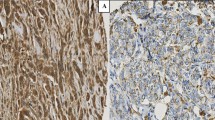Abstract
OBJECTIVE The aim of this study was to investigate the correlation between cathepsin D (Cath-D) and estrogen receptor (ER)expression in breast cancer tissue and to explore the prognostic significance of their combined determination in breast carcinoma patients with positive axillary lymph nodes.
METHODS One hundred and thirty-eight cases of breast carcinoma were examined by immunohistochemistry (IHC) and the results relating to patient follow-up analyzed.
RESULTS The overall 5-year disease-free survival rate (DFS) was 60.9% (84/138) in the series. The positive rate of Cath-D expression in the tumor cells was 55.07% and the positive ER staining was 51.4%. A definite significant negative correlation was found between the positive rates for Cath-D and ER (r=−0.294, P=0.001) The Cath-D expression for the cases in clinical Stage II, ≥10 positive-node and recurrence or distant metastasis, was higher than that those cases in clinical Stage II with fewer node-metastasis and with 5 year DFS (X2=13.926, P=0.000; X2=13.070, P=0.001; X2=10.545, P=0.001). However, there was no significant difference of Cath-D expression between 2 groups of patients with different ages or among the different histopathologic types of the non-specific invasive carcinoma. In the combined examination of Cath-D and ER, the cases that were ER (+) and Cath-D (−) had the highest 5-year DFS compared to other situations. In contrast, the cases that were reversed in expression, ie, ER(−) and Cath-D(+), had a lower 5-year DFS. There was a significant difference between the 2 conditions (X2=18.675, P=0.000).
CONCLUSION A combined determination and analysis of Cath-D and ER expression may be more useful to establish a prognosis than the biological characteristics of carcinomas with positive lymph nodes.
Similar content being viewed by others
References
Fu XL. Histopathologic Diagnosis. Chinese Common Malignant Tumor Diagnosis and Treatment Rule. Breast Carcinoma Volume (2nd Ed). Beijing: Beijing Medical University and Chinese Union Medical University Union Publisher. 1999;23.
Sanchez LM, Ferrando AA, Diez-Ltza I, et al. Cathepsin D in breast secretions from women with breast cancer. Br J Cancer. 1993:67:1076–1081.
Rocherort H. Biological and clinical vignificance of Cathepsin D in breast cancer. J Cell Biol. 1987;105:1937–1939.
Jahkola T, Toivonen T, Von-Smitten K, et al. Cathepsin-D, ukokinase plasminogen activa tor and type-1 plasminogen activator inhibitor in early breast cancer: an immunohistochemical study of prognostic value and relations to tenascin-C and other factors. Br J Cancer. 1999;80):167–174.
Hawkins RA, Tesdale AL, Killen ME, et al. Prospective evaluation of prognostic factors in operable breast cancer. Br J Cancer. 1996;74:1469–1478.
Li SL. Oncology of Breast (Chinese). Beijing:People’s Medical Publishing House. 2000;4.
Liebert A, Quietzsch D, Beier L. Comparison of the tumor associated proteases cathepsin D (CATH D) and urokinase-type plasminogen activator (uPA) in cytosols of human breast cancer patients. Anticancer Res. 1999;19:2571–2576.
Dittadi R, Biganzoli E, Boracchi P, et al. Impact of steroid receptors, pS2 and cathepsin D on the outcome of N + postmenopausal breast cancer patients treated with tamoxifen. Int J Biol Markers. 1998;13:30–41.
Pujol P, Daures JP, Brouillet JP, et al. Time at surgery during menstrual cycle and menopause affects pS2 but not cathepsin D levels in breast cancer. Br J Cancer. 1999;79:909–914.
Athanassiadou P, Sakellariou V, Michalas S, et al. Immunocytochemical localization of Cathepsin D and CA 125 in ovarian cancer. Int J Gynaecol Obstet. 1997;56:31–37.
Author information
Authors and Affiliations
Corresponding author
About this article
Cite this article
Niu, Y., Yang, X., Fan, Y. et al. The prognostic significance of a combined determination of cathepsin D and estrogen receptors in breast carcinomas with positive axillary lymph nodes. Chin. J. Clin. Oncol. 3, 172–175 (2006). https://doi.org/10.1007/s11805-006-0113-1
Received:
Accepted:
Issue Date:
DOI: https://doi.org/10.1007/s11805-006-0113-1



